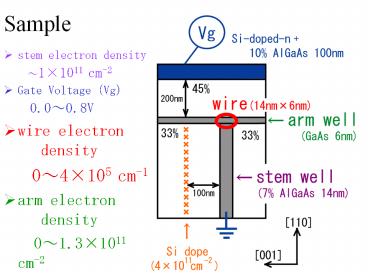stem electron density PowerPoint PPT Presentation
Title: stem electron density
1
Sample
- stem electron density
- 11011 cm-2
- Gate Voltage(Vg)
- 0.00.8V
- wire electron density
- 04105 cm-1
- arm electron density
- 01.31011 cm-2
2
Scan 1
wire trion
PL
1µm step
0.2µm step scan
- Micro PL measurement with 1µm / 0.2µm step
automatic scanning enables us to find the center
(blue circle) at every experiments.
- Gate Voltage 0.1V
- T5K
- Stem well excitation with cw TiSa laser
(?750nm ) 0.2µW?1µm2 spot size - Reflection geometry
- Resolution 0.15meV
Photon Energy (eV)
3
Scan 2
Gate Voltage 0.1V
check all available aria with 500µm ( 1.0µm step
) scanning
wire trion
arm exciton
PL
continue more than 500µm
4
0.5µm step scanning with various Gate Voltage (
Vg )
scan 3
T5K
PL
Vg0.3V
Vg0.7V
Vg0.5V
Vg0.1V
Photon Energy (eV)
? find the high quality aria (for example blue
arrow)
5
Gate Voltage dependence
?
PL
?
T5K
Vg 0V0.7V (0.05V step) corresponds n1D
04105cm-1 EFE 01.8meV
?
?low electron density ?1.569eV exciton peak
?
?trion peak 2.3meV below exciton peak (trion
binding energy)
?
?high density ?band to band transition?electron
plasma state
?Band Gap Renormalization(BGR)
?Fermi Edge Singularity(FES)
6
Temperature dependence
- ?BGR at every temperature
- ?ratio of exciton / trion peak become large with
temperature
?FES disappear at high temperature
T5K
T50K
T40K
T30K
?
?
?
?
?
?
?
?
Photon Energy (eV)
7
Temperature dependence of Energy shift
- compare BGR
- at Gate Voltage 0.2V0.7V
T (K) BGR(meV)
5 2.1
30 1.4
40 1.4
50 1.0
5K
30K
40K
Small BGR at high temperature
?
?
?
?
50K
Photon Energy (eV)
8
Temperature dependence of FWHM
- trion peak (Vg0.20.3V)
T (K) FWHM(meV)
5 0.7
30 1.5
40 2.0
50 2.3
50K
40K
At high Gate Voltage (Vg0.4V) temperature
dependence of FWHM is very small
30K
5K
?
?
?
?
Photon Energy (eV)
Photon Energy (eV)
9
PL PLE of wire
polarization
excitation
PL detection is perpendicular to the laser
excitation to improve S/N ratio. Vg 0.15V T
5K
detect
LHlight hole HHheavy hole
wire HH
PLE
stem LH
arm LH
arm HH
PL
stem HH
Photon Energy (eV)
10
Low density
PLE
PL
0.4V
H
Gate Voltage 0.0V0.4V
?
0.3V
?
0.2V
?neutral exciton (exciton) ?charged exciton
(trion) ?FES
?
density
0.15V
n1D
?
0.1V
L
0.0V
Photon Energy (eV)
Theoretical workM. Takagiwa, T. Ogawa, 2001
11
High density
PLE
PL
?
?
?
0.7V
Gate Voltage 0.4V0.7V
0.6V
0.5V
electron plasma
0.4V
0.35V
0.25V
?Fermi Edge ?Band Edge ????
0.15V
Photon Energy (eV)
12
PLE trion?electron plasma
- Electron density dependence of PLE varies with
the position of the wire.
( PLE ) Vg 0.3V Vg 0.35V Vg 0.4V Vg
0.45V Vg 0.5V (PL) Vg 0.15V
PLE
PLE
PLE
PL and PLE intensity arb. Uuits
PL
PL
PL
Photon Energy eV
13
High resolution PLE
PLE
PL
- PLE (Vg0.15) and PL(Vg0.12) at different
position of wire. - Resolution of PL 0.15meV, PLE 0.04meV?
- The gap between exciton peaks (or trion peaks)
varies with electron density from 0.3meV to
0.5meV. This is probably due to stem well ML
fluctuation (theoretical calculation stem well
ML fluctuation is 0.3meV).
PL and PLE intensity arb. Uuits
Photon Energy eV
Photon Energy eV
14
exciton shift
PLE
0.14V
- Exciton peak shifts with electron density
- 3.5meV / V ( blue line ).
- FWHM of PL spectrum (corresponds EF) changes
3.5meV/V. - Trion peak doesnt shift.
- Equation below can be expected.
0.12V
0.10V
0.08V
0.06V
0.04V
exciton
trion
exciton
trion
0.02V
0.0V
15
2D(arm well) / 1D
EF
EF
wire
well
(meV)
(meV)
1.8
1.8
? Eb wire Eb2.3meV well Eb1.4meV
? wireblue shift, rapid damping wellblue shift, broadening
? trion absorp wireno shift, rapid damping wellblue shift, broadening
? wirelarge blue shift well small blue shift begins from trion peak smoothly
?
?
1.5
1.5
exciton Absorp.
1.1
1.1
?
0.8
0.8
?
?
0.5
0.5
?
0.2
0.2
?
plasma absorp.
?
V. Huard et al. Phys. Rev. Lett. 84 (2000) 187

